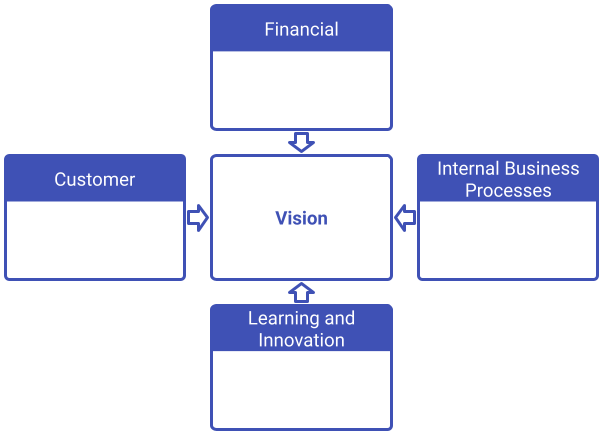 Introduction
Introduction
StratNavApp.com uses the balanced scorecard as a framework for organising goals that highlights their different natures and the relationships between them.
The Balanced Scorecard (BSC) is a strategic management tool that helps organisations track performance and manage strategy by measuring both financial and non-financial metrics.
As the name implies, the Balanced Scorecard Framework also helps to maintain a balance between:
- Financial and non-financial considerations,
- Shareholder/owner, staff and customer interests,
- Leading and lagging outcomes,
- Internal and external factors, and
- Hard and soft impacts
The Four Perspectives of the Balanced Scorecard
The balanced scorecard framework divides your goals in a business strategy into four perspectives.
- Financial goals are about how you create value to satisfy owners (such as shareholders and investors) and invest in future opportunities.
They answer: what does success look like to the owners of the organisation?
This typically leads to KPIs related to things like revenue, profit margins, operating costs and return on investment - Customer goals are about what your customers want and value.
They answer: What does success look like to the customers of the organisation?
This typically leads to KPIs related to things like customer satisfaction and net promoter scores (NPS), and customer retention rates. - Internal Business Processes goals are about getting better at what you do.
They answer: What processes does the organisation need to improve in order to deliver the customer and financial goals?
This typically leads to KPIs related to things like efficiency and effectiveness (productivity) of operations as well as quality control. - Learning and Innovation goals are about building the capabilities you will need to improve your business.
They answer: What capabilities does the organisation need to be able to thrive and to be able to continue to improve and adapt in the face of a changing and competitive environment? Also, what does success look like to the employees of the organisation? This often focuses on employee training, corporate culture and organisational development, including hiring, firing, promoting and success planning.
This typically leads to KPIs related to things like employee satisfaction, training completion rates and innocation.
The four perspectives of the Balanced Scorecard are fixed and can't be changed, added or removed.
Cause and Effect Relationships between the Perspectives
There is an implied cause and effect relationship between the four perspectives.
- Achieving your Learning and Innovation goals should enable you to achieve your Internal Business Process Goals.
- Achieving your Business Process goals should enable you to achieve your Customer goals.
- Achieving your Customer goals should enable you to achieve your Financial goals.
How many goals should an organisation have? An organisation should have 2 to 5 goals in each of those four perspectives. This means that an organisation should have 8 to 20 goals in total. Hint: Aim for somewhere in the middle of that range.
How to implement a Balanced Scorecard
Creating and implementing a Balanced Scorecard involves several steps:
-
Define Strategic Goals and Objectives: Establish clear goals and objectives across the four perspectives, based on your strategic analysis and supporting your vision and mission.
-
Develop Measures and KPIs: For each objective, define specific measures or KPIs to track progress. These measures should be clear, quantifiable, and aligned with strategic goals.
-
Set Targets: Establish realistic yet challenging targets for each measure. These targets should be specific and time-bound.
-
Identify Strategic Initiatives: Outline the key projects and actions required to achieve the targets. Each initiative should have clear ownership, timelines and resourcing.
-
Create a Strategy Map: Understand the cause-and-effect relationships between the goals and objectives across the four perspectives. This helps in understanding how different goals interrelate and support the overall strategy.
-
Regular Review and Adaptation: Continuously monitor performance, review progress against targets, and adjust strategies as needed. This involves using feedback loops to improve processes and strategic alignment.
NB: StratNavApp.com's AI can assist you by suggesting examples of suitable candidates for strategic goals, objectives, KPIs and initiatives based on your strategic analysis. It will also help you to monitor your KPIs and Initiatives and identify where adjustments to your strategy may be required.
Benefits of the Balanced Scorecard
The Balanced Scorecard offers numerous benefits:
- Holistic View: It provides a comprehensive view of organisational performance, integrating financial and non-financial, leading and lagging metrics.
- Strategic Alignment: It helps align business activities with the organisation’s vision and strategy.
- Improved Communication: By linking strategic goals and objectives to specific measures, it enhances communication within the organisation.
- Enhanced Decision-Making: It enables better decision-making by providing relevant and balanced performance data.
- Focus on Long-Term Goals: It ensures that organisations do not focus solely on short-term financial outcomes but also consider long-term strategic objectives.
Origins of the Balanced Scorecard
The Balanced Scorecard (BSC) methodology was introduced in the early 1990s by Dr. Robert S. Kaplan, a professor at Harvard Business School, and Dr. David P. Norton, a management consultant. Initially presented in a 1992 Harvard Business Review article titled "The Balanced Scorecard—Measures that Drive Performance," the BSC was developed as a performance management tool that goes beyond traditional financial metrics to include non-financial aspects that are crucial for a company's success.
Kaplan and Norton observed that relying solely on financial outcomes was insufficient for capturing the full picture of a business's health and performance. They proposed the Balanced Scorecard as a more holistic approach that evaluates an organization's operations from four perspectives: Financial, Customer, Internal Business Processes, and Learning and Growth. This method enables organisations to balance short-term objectives with long-term strategic goals, hard and soft metrics, and leading and lagging indicators, providing a more comprehensive view of performance and guiding strategic planning and execution. The BSC has since become a widely adopted strategic management tool, helping organizations across various industries align business activities to their vision and strategy, improve internal and external communications, and monitor performance against strategic goals.
Where to find the Balanced Scorecard template
To find your Balanced Scorecard template:
- Sign up/sign in to StratNavApp.com.
- Select the project you want to work with.
- Click on "Direction" on the main menu.
- Select "Goals" on the model selector on the page that follows.
- Then select "Balanced Scorecard" on the second selector which appears.
Using StratBot AI on the Balanced Scorecard
StratNavApp.com's StratBot AI can suggest Goals in each of the four perspectives of the balanced scorecard based on all the information you've already captured about your strategy: analysis, mission, vision, values, etc.
At the click of a button, StratBot will suggest goals that you can easily add, amend, or ignore.
Other resources:
- How to measure success against strategic vision and goals
- Introductory Video Course: Chapter 8: The Balanced Scorecard, Goals, Objectives and Checking AI
